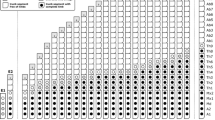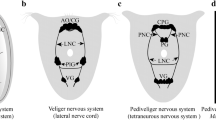Summary
The cephalic sensory organ in the veliger larva of Rostanga pulchra is situated dorsally between the rhinophores, emerging as a tuft of cilia. This organ is made up of three types of sensory cells, and based on their morphology have been termed ampullary, parampullary and ciliary tuft cells. The cell bodies of the organ originate in the cerebral commissure, and their dendrites pass to the epidermis as three tracts. Dendrites terminate in the epidermis to form a sectorial field. Axons of these cells run into the mass of neurites in the cerebral commissure but no synapses were observed in this area. Morphological evidence suggests that the cephalic sensory organ may function in chemoreception and mechanoreception related to substrate selection at settlement, feeding, or other behaviors.
Similar content being viewed by others
References
Alkon DL, Akaike T, Harrigan J (1978) Interaction of chemosensory, visual, and statocyst pathways in Hermissenda crassicornis. J Gen Physiol 71:177–194
Altner H, Prillinger L (1980) Ultrastructure of invertebrate chemoreceptors, thermoreceptors and hygroreceptors, and its functional significance. Intern Rev Cytol 67:69–140
Audesirk G, Audesirk T (1980a) Complex mechanoreceptors in Tritonia diomedea. I. Responsiveness to mechanical and chemical stimuli. J Comp Physiol 141:101–109
Audesirk G, Audesirk T (1980b) Complex mechanoreceptors in Tritonia diomedea. II. Neuronal correlates of a change in behavioral responsiveness. J Comp Physiol 141:111–122
Bonar DB (1978a) Ultrastructure of a cephalic sensory organ in larvae of the gastropod Phestilla sibogae (Aoelidacea, Nudibranchia). Tissue Cell 10:153–165
Bonar DB (1978b) Morphogenesis at metamorphosis in opisthobranch molluscs. In: Chia FS, Rice MF (eds) Settlement and metamorphosis of marine invertebrate larvae. Elsevier/North Holland, New York, pp 177–196
Bonar DB, Hadfield MG (1974) Metamorphosis of the marine gastropod Phestilla sibogae Bergh (Nudibranchia: Aoelidacea). I. Light and electron microscope analysis of larval and metamorphic stages. J Exp Mar Biol Ecol 16:227–255
Chia FS, Koss R (1978) Development and metamorphosis of the planktotrophic larvae of Rostanga pulchra (Mollusca: Nudibranchia). Mar Biol 46:109–119
Chia FS, Koss R (1982) Fine structure of the larval rhinophores of the nudibranch, Rostanga pulchra, with emphasis on the sensory receptor cells. Cell Tissue Res 225:235–248
Chia FS, Koss R (1983) Fine structure of the larval eyes of Rostanga pulchra (Mollusca, Opisthobranchia, Nudibranchia). Zoomorphology 102:1–10
Chia FS, Atwood DG, Crawford BJ (1975) Comparative morphology of echinoderm sperm and possible phylogenetic implications. Am Zool 15:553–565
Crisp M (1971) Structure and abundance of unspecialized external epithelium of Nassarius reticulatus (Gastropoda, Prosobranchia). J Mar Biol Assoc UK 51:865–890
Emery DG (1976) Observations on the olfactory organ of adult and juvenile Octopus joubini. Tissue Cell 8:33–46
Emery DG, Audesirk TE (1978) Sensory cells in Aplysia. J Neurobiol 9:173–179
Kataoka S (1976) Fine structure of the epidermis of the optic tentacle in a slug, Limax flavus. Tissue Cell 8:47–60
Lacalli TC (1983) The brain and central nervous system of Muller's larva. Can J Zool 61:39–51
Laverak MS (1974) The structure and function of chemoreceptor cells. In: Grant PT, Mackie AM (eds) Chemoreception in marine organisms. Academic Press, New York, pp 1–48
Mackie GO, Singla CL, Thiriot-Quievreux C (1976) Nervous control of ciliary activity in gastropod larvae. Biol Bull 151:182–199
Matera EM, Davis WJ (1982) Paddle cilia (discocilia) in chemosensitive structures of the gastropod mollusk Pleurobranchia california. Cell Tissue Res 222:25–40
Phillips CFA (1979) Ultrastructure of sensory cells on the mantle tentacles of the gastropod Notoacmea scutum. Tissue Cell 11:623–632
Richardson KC, Jarrett L, Finke EH (1960) Embedding in epoxy resins for ultrathin sectioning in electron microscopy. Stain Technol 35:313–323
Rieger R, Tyler S (1979) The homology theorem in ultrastructural research. Amer Zool 19:655–664
Ruppert EE (1978) A review of metamorphosis of turbellarian larvae. In: Chia FS, Rice MF (eds) Settlement and metamorphosis of marine invertebrate larvae. Elsevier/North Holland, New York, pp 65–81
Schacher S, Kandel ER, Woolley R (1979) Development of neurons in the abdominal ganglion of Aplysia californica. II. Nonneural support cells. Develop Biol 71:176–190
Storch V, Welsch V (1969) Über Bau und Function der Nudibranchier-Rhinopheron. Z Zellforsch 97:528–536
Switzer-Dunlap M (1978) Larval biology and metamorphosis of aplysiid gastropods. In: Chia FS, Rice ME (eds) Settlement and metamorphosis of marine invertebrate larvae. Elsevier/North Holland, New York, pp 197–206
Wood RL, Luft JH (1965) The influence of buffer systems on fixation with osmium tetroxide. J Ultrastruct Res 12:2245
Wright BR (1974a) Sensory structure of the tentacles of the slug Arion ater (Pulmonata, Mollusca) 1. Ultrastructure of the distal epithelium, receptor cells and tentacular ganglion. Cell Tissue Res 151:229–244
Wright BR (1974b) Sensory structure of the tentacles of the slug Arion ater (Pulmonata, Mollusca) 2. Ultrastructure of the free nerve endings in the distal epithelium. Cell Tissue Res 151:245–257
Zylstra U (1972) Distribution and ultrastructure of epidermal sensory cells in the fresh water snails Lymnaea stagnalis and Biomphalaria pfeifferi. Neth J Zool 22:283–298
Author information
Authors and Affiliations
Rights and permissions
About this article
Cite this article
Chia, F.S., Koss, R. Fine structure of the cephalic sensory organ in the larva of the nudibranch Rostanga pulchra (Mollusca, Opisthobranchia, Nudibranchia). Zoomorphology 104, 131–139 (1984). https://doi.org/10.1007/BF00312131
Received:
Issue Date:
DOI: https://doi.org/10.1007/BF00312131




